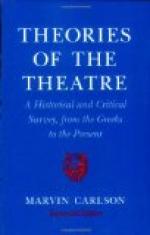In order to succeed in a theatre such as this, the drama was necessarily forced to be a Drama of Rhetoric. From 1576, when James Burbage built the first play-house in London, until 1642, when the theatres were formally closed by act of Parliament, the drama dealt with stately speeches and with high astounding terms. It was played upon a platform, and had to appeal more to the ears of the audience than to their eyes. Spectacular elements it had to some extent,—gaudy, though inappropriate, costumes, and stately processions across the stage; but no careful imitation of the actual facts of life, no illusion of reality in the representment, could possibly be effected.
The absence of scenery forced the dramatists of the time to introduce poetic passages to suggest the atmosphere of their scenes. Lorenzo and Jessica opened the last act of The Merchant of Venice with a pretty dialogue descriptive of a moonlit evening, and the banished duke in As You Like It discoursed at length upon the pleasures of life in the forest. The stage could not be darkened in Macbeth; but the hero was made to say, “Light thickens, and the crew makes wing to the rooky wood.” Sometimes, when the scene was supposed to change from one country to another, a chorus was sent forth, as in Henry V, to ask the audience frankly to transfer their imaginations overseas.
The fact that the stage was surrounded on three sides by standing spectators forced the actor to emulate the platform orator. Set speeches were introduced bodily into the text of a play, although they impeded the progress of the action. Jacques reined a comedy to a standstill while he discoursed at length upon the seven ages of man. Soliloquies were common, and formal dialogues prevailed. By convention, all characters, regardless of their education or station in life, were considered capable of talking not only verse, but poetry. The untutored sea-captain in Twelfth Night spoke of “Arion on the dolphin’s back,” and in another play the sapheads Salanio and Salarino discoursed most eloquent music.




